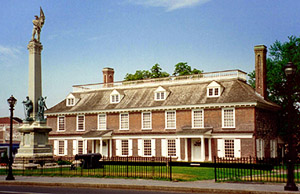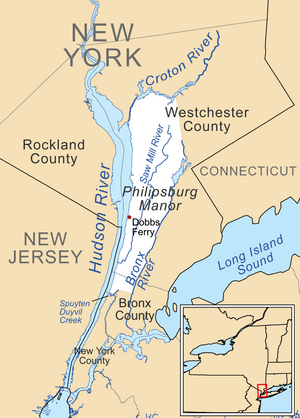Philipse Manor Hall State Historic Site facts for kids
|
Philipse Manor Hall
|
|

The Manor house
|
|
| Location | Yonkers, New York |
|---|---|
| Built | c.1682 |
| Architect | Frederick Philipse |
| NRHP reference No. | 66000585 |
Quick facts for kids Significant dates |
|
| Added to NRHP | October 15, 1966 |
| Designated NHL | November 5, 1961 |
Philipse Manor Hall State Historic Site is a really old house in Yonkers, New York. Today, it's a historic house museum, which means it's a place where you can visit and learn about history. This building was once the main home for the Philipse family. Later, it even served as the city hall for Yonkers! It's the second oldest building still standing in Westchester County, New York. You can find it near the Hudson River. The New York State Office of Parks, Recreation and Historic Preservation now owns and takes care of this important historical site.
Contents
The Manor Hall's Early Days
The oldest part of Philipse Manor Hall was built around 1682. It was built by a Dutch merchant named Frederick Philipse and his wife, Margaret Hardenbroeck. Frederick Philipse was the first "Lord" of Philipsburg Manor. This meant he owned a huge amount of land. By the time he passed away, his estate was about 52,000 acres. This land covered all of modern-day Yonkers, New York and much more of Westchester County.
How the Philipse Family Used the House
When Frederick Philipse was alive, the house was mostly a stopping point. It was a place to rest during long trips up and down the Hudson River. These trips were between his home in New Amsterdam (which is now New York City) and the northern parts of his large estate.
Later, his grandson, Frederick Philipse II, and his great-grandson, Frederick Philipse III, made the house bigger. They also made it much nicer. It became the main home for the Philipse family.
The Manor Hall During the American Revolution
On November 28, 1776, something big happened. This was almost five months after the United States Declaration of Independence was signed. Frederick Philipse III and over 200 other people signed a paper. They said they were still loyal to the British Crown. This meant they did not want to support the American Revolution.
Why the Philipse Family Left
Because he was loyal to the British, Frederick Philipse III was seen as a traitor. General George Washington ordered his arrest. He was held in Connecticut for a while. He was allowed to go back to Yonkers to sort out his things. But he had to promise not to help the British. However, he and his family did not keep this promise. They ran away to New York City, which was controlled by the British. Later, they went to Great Britain. They left their large estate and Philipse Manor Hall behind. In 1779, their property was taken by the new American government.
What Happened to the Land
The Philipse family owned a lot of land. This included a huge area that is now Putnam County, New York and part of Dutchess County, New York. During the Revolution, New York's government sold these lands. They were sold at public auctions.
After the Philipse family left, different families lived in Philipse Manor Hall. This was during the 1800s.
Philipse Manor Hall as City Hall
In 1868, the building became the main government center for Yonkers. It was first the Village Hall and then the City Hall. It stayed this way until 1908. During this time, a special monument was put on the east lawn. This monument honored the people from Yonkers who had died in the American Civil War.
Saving the Historic Building
By 1908, the city government had grown too much for the old building. It was becoming too small to use as a government center. People talked about adding new parts to the building. Some even thought about tearing it down.
But then, a kind person named Eva Smith Cochran stepped in. She was from a rich family that owned carpet mills nearby. She gave $50,000 to the city. This money was to thank them for taking care of the building for 40 years. This gift allowed the city to give the building to the State of New York.
From that time until the 1960s, the state owned the building. The American Scenic and Historic Preservation Society helped take care of it. After that group ended, the New York State Office of Parks, Recreation and Historic Preservation took over. They now own, keep up, and manage the building as a museum.
Restoring the Manor Hall
From 1911 to 1912, the house went through a big restoration project. This project made the house look more like it did in colonial times. Since 1912, the building has been open as a museum. You can learn about its history, art, and architecture there. In 1961, the building was named a National Historic Landmark. This means it's a very important historical place in the United States.
Amazing Collections Inside
Philipse Manor Hall has some special things inside. One of the most interesting is a ceiling from around 1750. It's made of papier-mâché and plaster. This type of ceiling is called Rococo. It's one of only two such ceilings still in their original place in the United States.
What the Ceiling Shows
This fancy ceiling has many designs and pictures. They tell stories about Frederick Philipse III's life. For example, he loved music. So, the ceiling shows people playing lutes, bagpipes, and singing. He also enjoyed hunting. So, you can see hunting dogs and game birds. He was also educated in arts and sciences. So, there are busts (sculptures of heads) of famous thinkers like Alexander Pope and Sir Isaac Newton.
The City Council Chamber
Another important part of the building is the City Council Chamber. It was designed in 1868 by John Davis Hatch. The Chamber has a high, arched ceiling and beautiful wooden details. It was made to look like the grand hall of a typical English manor house.
The Cochran Art Collection
Throughout the house, you'll find paintings from the Cochran Collection of American Portraiture. This collection was put together by agents for Alexander Smith Cochran. He was Eva Smith Cochran's son and owned the family's carpet mills. The collection includes works by famous artists like Charles Willson Peale and John Trumbull. There are about 60 paintings in total. They show almost all of the early presidents of the United States, from Washington to Calvin Coolidge. You can also see paintings of war heroes, other historical figures, and members of the Philipse family.
See also
- Philipsburg Manor House
- List of National Historic Landmarks in New York
- List of the oldest buildings in New York



